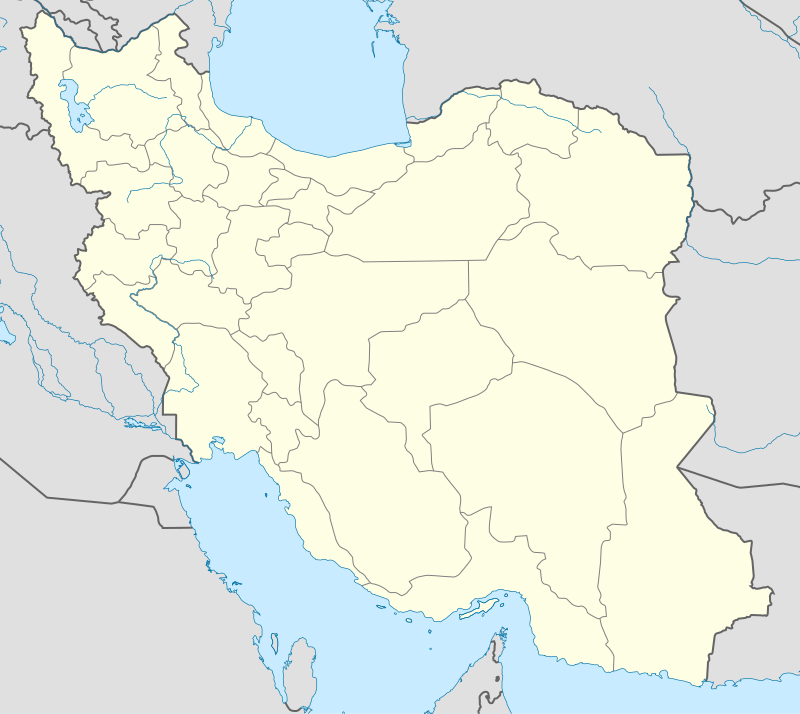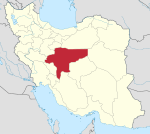Khomeyni Shahr
Khomeyni Shahr (Persian: خمينی شهر, also Romanized as Khomeynī Shahr and Khomeynīshahr; from the 1930s until 1979, known as Homāyūnshahr or Homayoon Shahr (همایونشهر); known as Sedeh (سده) prior to the 1930s)[2] is a city and capital of Khomeyni Shahr County, Isfahan Province, Iran. At the 2006 census, its population was 218,737, in 57,551 families.[3]
Khomeyni Shahr خمينی شهر مهربین Mehrbin | |
|---|---|
City | |
 Khomeyni Shahr | |
| Coordinates: 32°42′01″N 51°31′16″E | |
| Country | |
| Province | Isfahan |
| County | Khomeyni Shahr |
| Bakhsh | Central |
| Population (2016 Census) | |
| • Urban | 247,128 [1] |
| Time zone | UTC+3:30 (IRST) |
| • Summer (DST) | UTC+4:30 (IRDT) |
Khomeyni Shahr is now part of the Isfahan Metropolitan area.
The town was originally known as Sedeh. In the 1930s, the name was changed to Homayunshahr. After the Iranian Revolution of 1979, the city was renamed again to Khomeyni Shahr (meaning "City of Khomeyni"), in honor of Ayatollah Khomeini. Locals have continued to refer to the city as Sedeh. There has been an ongoing effort to rename back the city's name to its historical one Mehrbin (مهربین).
History
It is commonly believed that the original name, Sedeh (Persian: سده), is derived from Seh-dedge, meaning "three castles" in Persian, ("dedge" (دژ) means "castle"), and is linked to the formation of the town by the growth of three neighbouring castles. The three main castles of Kohan Dedge, Gar Dedge, and .... Dedge (locally pronounced kohan dedge, gar dar and ...).
It is commonly believed that Seh-dedge was a Sassanian military base and an old fireplace (atash gah) based on top of the mountain near the town.
The three main villages of Khouzan (locally pronounced Khizoon), Foroushan (the origin of Foroushan was Parishan (pari (angel) + voshan (face))), and Varnosfaderan (Venesfohoon) remain identifiable parts of the city. However, there are in fact five former villages forming identifiable parts of the town. This has led to the argument that the name may be linked to the ancient Persian festival of Sadeh.
The name change to Homayunshahr took place during the reign of Reza Shah Pahlavi. The name literally means "auspicious or august city", but Homayun was also a title of the Shah and so the name was seen as being linked with the Pahlavi dynasty. Thus, after the revolution of 1979, the city was renamed again, this time to be called after Ayatollah Khomeini, the leader of the revolution.
Khomeini Shahr antiquity
Many of the historical events of Khomeini Shahr are influenced by the events that took place in Isfahan. However, the historical antiquity of this region dates back to the Sassanid era, the ancient fortress which is located on the way to Isfahan, seems to have been the capital of the Sassanids. In the Islamic era, this area was also very important, and the existence of a large Grand Mosque in Khozan Alley shows that it was a city in the past. Because the Grand Mosque is an urban feature and the villages do not have it. In Mohammad Afghan's invasion of Isfahan, the people of the century bravely persevered and captured a large number of Mahmoud's troops.
The distance between the city (Khomeini Shahr) and Isfahan is 8 km. Khomeini Shahr city is located in the west of Isfahan province and is limited to Borkhar and Maymeh cities in the north, Falavarjan city in the south, Isfahan city in the east and Najafabad city in the west. This city is one of the most pleasant and most prosperous areas of Isfahan province. Its soil is irrigated by the Zayandehrud River and all its streams are full of water. In addition, it has important caries, which has caused three-quarters of the city's soil to be large orchards and a quarter of its fields.
The material of "Qomish" passes through the southern lands of the city, and because it is connected to the springs at the point of separation from the river, its water never runs out.
Fruits and ground products such as wheat, barley, cucumbers, melons, legumes, tobacco are grown in the city, and some varieties such as spring melons, pavilions, grapes, cherries, Nasrabad and Gortan are famous and similar in other places. Not found.
Its climate is temperate and dry. The highest temperature in summer is 39 degrees above zero and the lowest in winter is 8 degrees below zero.
Since Khomeini Shahr was formed from three dozen names called Khozan, Forosh and Vernosfadran, it was called (three ten) which was gradually renamed Homayounshahr and then Khomeini Shahr due to the expansion of these villages and their connection to each other.
Sections and neighborhoods
There are several antiquities in the city.
Vernosfadran (including the neighborhoods of Garsele, Zaghabad or Zoga, Balugan, Garder and Kushkbaj) Khozan (including the neighborhoods of Ko Barz or Ko Bazm or Coin Al-Zar, Fatehabad, Jafarabad, Darb-e Mahkameh, Kohandj and Shamsabad) Vendors (including the neighborhoods of Dimitrian, the upper door of the dead, Javadiyeh or Uncle Fazlgah, the door of Seyed, the castle of Agha, Ladreh, the new neighborhood, Sarpol) Andoan Adrian Heristan Qartman (Kurtman) Vaziche Joy Abad کندندژ Dastgerd Qadadeh Esfriz What Tiranchi Pavilion Asgharabad Amirieh Castle New sections include:
Manzaria town Seven hundred devices Qaemiyeh (former slaughterhouse) guards University of Technology staff dormitory (Baqer al-Ulum) Among the industrial and workshop sections, the following can be mentioned:
Dushakh Industrial Zone Kokuchi area (small mountain) Electronic Industrial Town
University
The Islamic Azad University of Khomeinyshahr is one of the most promising Iranian universities in various fields, especially in mechanical
Isfahan University of Technology (IUT) is ranked as one of the best universities in Iran.
The city contains many historical buildings and is a good place to welcome tourists. One of the most beautiful historical buildings is Sartip's house located in downtown.
References
- https://www.amar.org.ir/english
- Khomeyni Shahr can be found at GEOnet Names Server, at this link, by opening the Advanced Search box, entering "6013273" in the "Unique Feature Id" form, and clicking on "Search Database".
- "Census of the Islamic Republic of Iran, 1385 (2006)". Islamic Republic of Iran. Archived from the original (Excel) on 2011-11-11.
